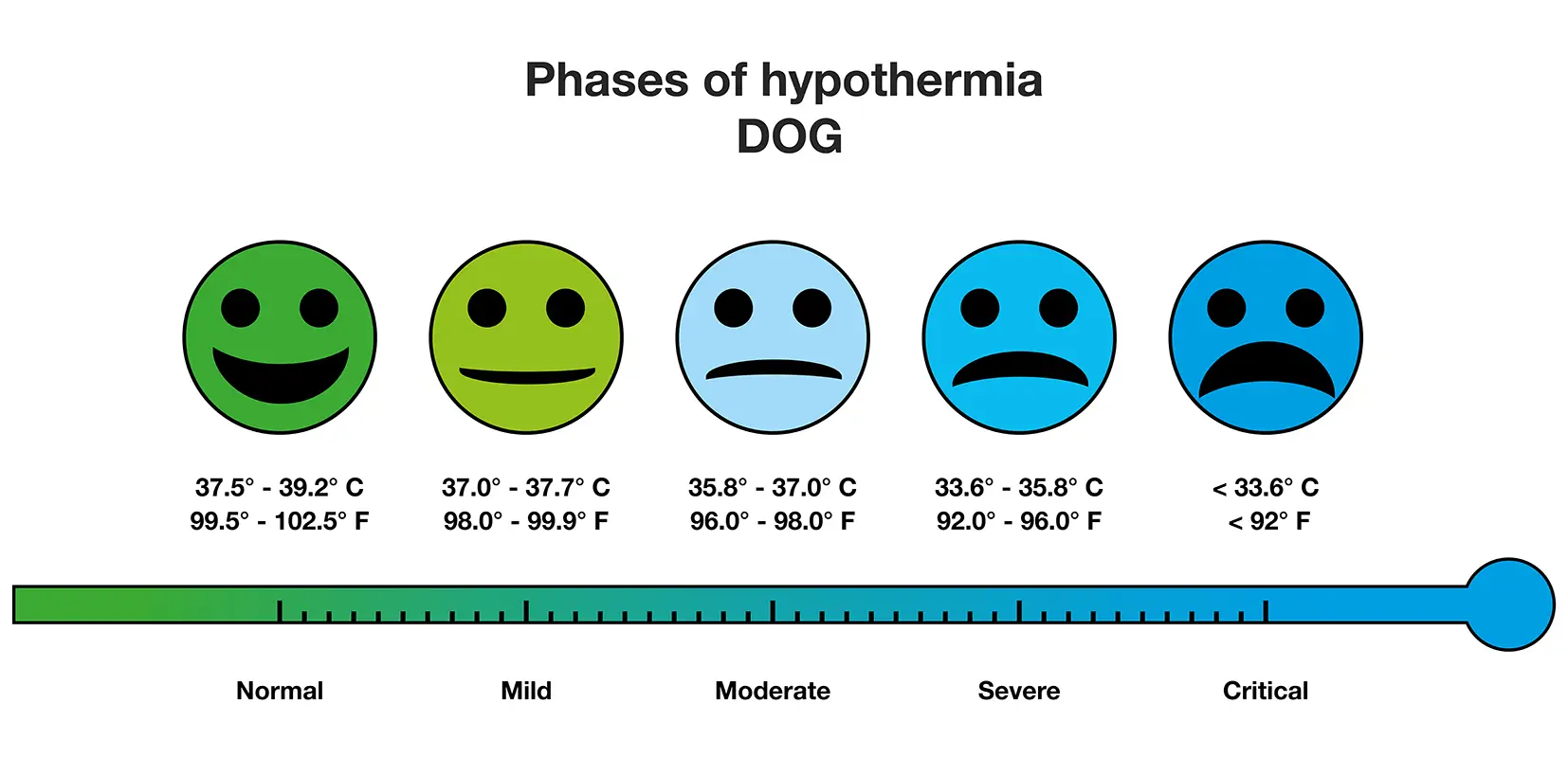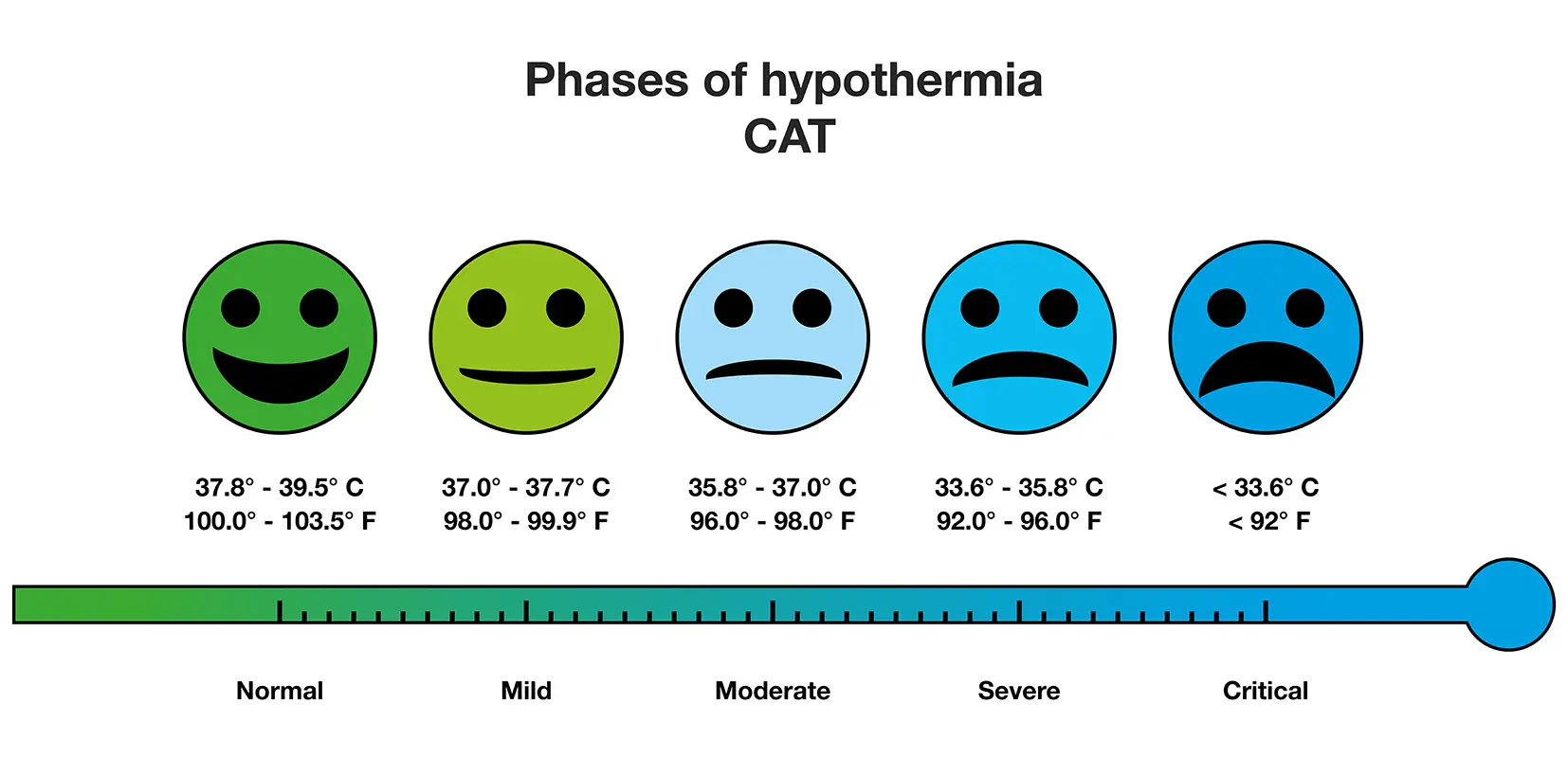Veterinary Expert Technologies AG
Hypothermia = hypothermia (drop in body temperature below the reference range)
Hypothermia is a common, often overlooked and underestimated complication of anesthesia and light anesthesia (general anesthesia), which is usually difficult to combat. During anesthesia, the patient's temperature drops due to reduced muscle activity, reduced metabolic rate, dose-dependent depression of the heat regulation center by the anesthetic and peripheral vasodilation.
When not anesthetized, thermoregulatory responses begin when the temperature deviates by around 0.2°C, whereas under anesthesia, these only occur when the temperature deviates by 2 - 4°C. The body does not counteract the drop in temperature, and more heat is released than is produced. Long anesthesia times, low room temperatures, cool operating tables and operations on open body cavities also contribute to hypothermia.
Depending on the severity, hypothermia can have serious consequences for the patient or even lead to death. It can have significant effects on the metabolism, the cardiovascular system, the respiratory system and blood coagulation.
Common complications associated with hypothermia
- Altered drug effect (pharmacokinetics) of anesthetics and analgesics
- Dysfunction of organ systems
- Increased susceptibility for infection
- Impaired wound healing
- Altered coagulation
- Delayed wakening phase
- Delayed recovery
- Shivering leads to increased oxygen consumption as well as discomfort/pain
Those at highest risk for rapid and massive loss of body heat during anesthesia are puppies and young patients, geriatric patients, patients with a low fat content, patients whose body cavity is opened during surgery, including interventions on the oral cavity such as dental treatments, as well as cats, small dogs and small mammals (= relatively large body surface in relation to body mass).
It is always easier to prevent hypothermia than to treat it (=maintaining the physiological body temperature is more sensible than warming up measures)!
Early measures to minimize temperature drops should be implemented for every patient. Warming of the animal should begin before (“prewarming” for 30 - 60 minutes) or immediately after premedication during every anesthesia.
Literature
- Brodeur A, Wright A, Cortes Y. Hypothermia and targeted temperature management in cats and dogs. Journal of Veterinary Emergency and Critical Care. 27 (2): 151-163 (2017).
- Clark-Price S. Inadvertent perianesthetic hypothermia in small animal patients. Veterinary Clinics: Small Animal Practice, 45: 983-994 (2015).
- Hypothermie. In: Eberspächer-Schweda E, Hrsg. AnästhesieSkills. 2., aktualisierte und erweiterte Auflage. Stuttgart: Thieme (2020).
- Hypothermie. In: Erhardt W, Henke J, Haberstroh J, Baumgartner C, Tacke S, Lendl C, Wamser H, Hrsg. Praxisleitfaden Anästhesie und Analgesie. 1. Auflage. Stuttgart: Schattauer GmbH (2015).
- Herges S. Komplikationen in der Anästhesie beim Hund – was tun? Team Konkret, 20: 18-24 (2024).
- Kowalczyk L, Steinbacher R, Dörfelt R. Hypothermie während der Anästhesie – eine unterschätzte Komplikation. Tierärztliche Umschau. 65: 384-391 (2010).
- Oncken AK, Kirby R, Rudloff E (2001). Hypothermia in critically ill dogs and cats. Compendium. 23 (6): 506-521 (2001).
- Quandt J. Hypothermia in the operating room. Today’s Veterinary Practice. May/June: 70-74 (2018).
- Robertson, S. Hypothermia - More Important Than You Believe. World Small Animal Veterinary Association World Congress Proceedings, 2015.
- Scales C. Managing anaesthesia related hypothermia in cats and dogs. 2023. https://articles.burtonsveterinary.com/articles/managing-anaesthesia-related-hypothermia-in-cats-dogs
- Sessler DI. Perianesthetic thermoregulation and heat balance in humans. FASEB J. 7: 638-644 (1993).
- Somerkoski M. Ausmaß der Hypothermie und Hypothermieprävention bei Hunden in Allgemeinnarkose (Dissertation). 2008.
- Tischer A. Der Effekt von Wärme- und Feuchtigkeitsaustauschern auf die intraoperative Temperaturentwicklung bei Hund und Katze (Dissertation). 2010.
- Weidauer J, Alef M. Perioperatives Wärmemanagement. Kleintier Konkret. 3: 2-10 (2017).


